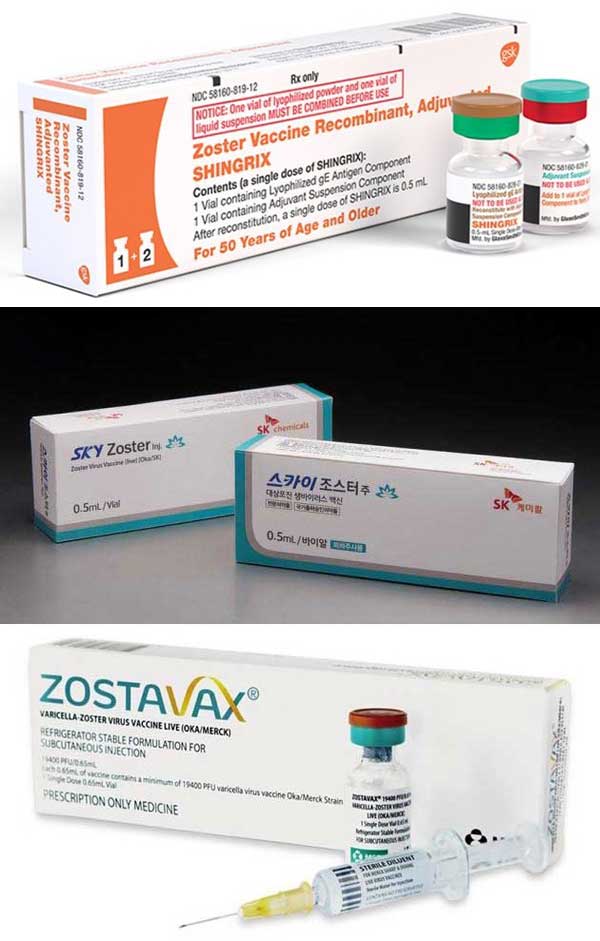Despite predictions that its high cost as a premium vaccine would be a barrier to market expansion, GSK's shingles vaccine, Shingrix, has claimed the top sales spot in the market in its first year of release.
Shingles is caused when the varicella-zoster virus (VZV), which causes chickenpox, becomes reactivated. When specific cellular immunity to VZV decreases below a certain threshold due to aging or weakened immunity, the body cannot overcome the reactivation of the virus, leading to shingles.

The Korean market currently has three products on the market, GSK's Shingrix, MSD's Zostavax, and SK bioscience's Skyzoster.
According to IQVIA, a drug market research firm, Shingrix's sales shot up to 38.5 billion won ($28.7 million), marking a 9,525 percent increase compared to the previous year. Shingrix's market share marked 44.2 percent, followed by SK bioscience's Skyzoster with 30.1 percent, and MSD's Zostavax with 25.7 percent.
Despite Shingrix's high price, it quickly increased its market share thanks to its strong preventive effect against shingles. Regarding vaccine prices, GSK's Shingrix costs about 500,000 won for two doses, MSD's Zostavax is priced at about 170,000 won, and SK bioscience's Skyzoster is around 150,000 won.
The greatest advantage of Shingrix is its strong preventive effect against shingles. Clinical trials targeting adults over 50 showed a protection rate of 97.2 percent and 97.9 percent in those over 70.
This is significantly higher compared to Zostavax, which showed a protection rate of 51 percent in patients over 60 years old and 41 percent in those over 70. Skyzoster is known to have a similar level of efficacy as Zostavax.
Shingrix also has a wider range of applications.
As an inactive vaccine, hospitals can use Shingrix in patients taking immunosuppressive drugs. Zostavax. Skyzoster, on the other hand, are live attenuated vaccines, making it hard for hospitals to use the vaccine on adults with low immunity.
This characteristic has significantly aided in expanding its market share.
Meanwhile, traditional shingles vaccines, such as SK bioscience's Skyzoster and MSD's Zostavax, grew in sales volume from last year but lost share to Shingrix.
SK bioscience's Skyzoster posted sales of 26.2 billion won last year, up 33.3 percent from the previous year. However, its market share fell to 30.1 percent in a year from 46.5 percent in 2022 due to the rise of Shingrix.
Zostavax sold 22.4 billion won last year, up 0.5 percent from the previous year, and its market share was 25.7 percent last year, the lowest among the three products.
The IQVIA data also showed that the most administered shingles vaccine was SK bioscience's Skyzoster.
Skyzoster sold 311,590 doses, ranking first in sales volume, followed by GSK's Shingrix (224,334) and MSD's Zostavax (223,842 doses).
Industry's attention now on possibility of shingles vaccines entering NIP
According to the National Health Insurance Service, the number of shingles patients treated in hospitals increased by 12.4 percent from approximately 640,000 in 2014 to about 740,000 in 2019.
As the number of shingles patients in Korea continues to increase, the potential inclusion of the shingles vaccine in the National Immunization Program (NIP), which is currently administered as a non-covered vaccine, is garnering attention.
With local governments already offering free shingles vaccines to individuals aged 65 and above, attention is now focused on whether President Yoon Suk Yeol will keep his promise that he made during his candidacy of including shingles vaccines in the NIP.
A policy research report by the Korea Disease Control and Prevention Agency (KDCA) in 2019 suggested that including the shingles vaccine in the NIP for the elderly would be cost-effective, with a 99.4 percent probability, compared to the current vaccination scenario.
Another study highlighted a potential cost-saving of approximately 4.7 trillion won (about 720,000 won per person) by vaccinating against shingles.
Also, during the National Assembly's audit of the KDCA, KDCA Commissioner Jee Young-mee stressed that the agency is analyzing the cost-effectiveness of the shingles vaccine, just like the HPV vaccine.
However, Jee explained that the shingles vaccine was put on the back burner because of the cost.
"However, we are again looking at including the shingles vaccine in the NIP and will find the most efficient way to proceed as soon as the results are available," Jee said.
Initially, SK bioscience and MSD were expected to be the biggest beneficiaries if the shingles vaccine is designated as an NIP. This is because the two vaccines, while less effective than Shingrix, have an advantage in terms of the number of doses and cost.
However, the situation seems to have changed recently, as the cost of a single dose of Shingrix is dropping in some local clinics to as low as 200,000 won.
A dermatologist who runs a clinic in Hwaseong, Gyeonggi Province, stressed that this may further change the shingles vaccine market landscape.
"The price of Shingrix is lower than when it was first launched, so I think the market share of Shingrix could increase further depending on how the company plans to price it in the future," the doctor told Korea Biomedical Review. "It is difficult to say about the NIP policy as a doctor who runs a local clinic, but if the price continues to be adjusted, there may be a possibility of Shingrix being included in the NIP even if it is more expensive because the efficacy is superior."

